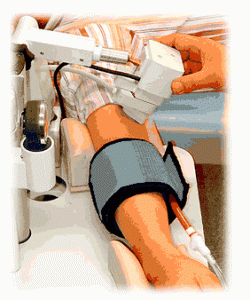FMD, Platelet Reactivity and Impact-R
Tuesday, December 20th, 2011What is FMD?
Flow-Mediated Dilatation is the increase in calibre of a blood vessel in response to increased blood flow. This was first described by Schretzenmayr. FMD is endothelium dependent, wherein the endothelium acts as a mechanotransducer that senses changes in shear stress and then determines the release of dilatators. Several dilator factors have been proposed to be involved in FMD: prostaglandins , ATP or an endothelium-derived hyperpolarizing factor, and nitric oxide (NO). An increased release of NO in response to increases in shear stress causes dilatation of underlying smooth muscle of conduit arteries.
Why is FMD significant?
A decreased FMD reflects endothelial dysfunction and may predict coronary artery disease in susceptible patients. The brachial artery FMD can be measured by ultrasound scan and acts as surrogate for the coronary vasculature which can only be assessed by more invasive methods.
How is FMD related to platelet reactivity?
Another effect of NO released by the endothelium under increased shear stress is decrease of platelet reactivity. Does it follow, therefore, that if decreased FMD determines endothelial dysfunction and decreased NO release, it also determines an increased platelet reactivity?
A study by Shechter, et.al. explores the association between platelet reactivity and brachial artery FMD in controls (without established cardiovascular disease) and in patients with acute myocardial infarction. Platelet reactivity was measured by conventional aggregometry and by the IMPACT-R machine. The study concludes that FMD is inversely correlated to platelet reactivity in both controls and AMI patients. An abstract of the said study can be found here.
